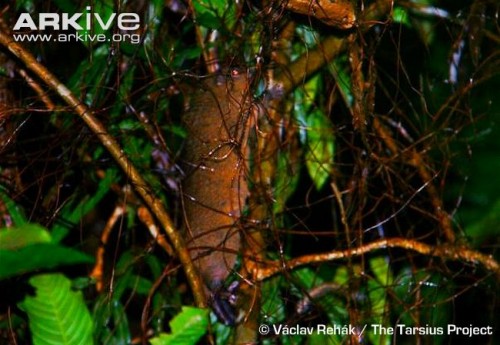This strikingly beautiful cloudrunner rat is endemic to Dinagat Island in the Philippines and until 2012 known only from a single specimen collected between 1974 and 1975 from Balitbiton, Loreto municipality, Surigao del Norte Province, Dinagat. In January 2012, the Dinagat Bushy-tailed Cloud Rat (Crateromys australiswas) was rediscovered by Czech researchers in a semi-protected watershed reserve site on central-north Dinagat. It has a chunky body, long tricoloured tail and tawny and orange fur. Nocturnal and arboreal, this species may be dependent on primary forest. Targeted surveys for this species have yet to be undertaken to determine how big its range is on Dinagat. The species may occur also on adjacent islands, especially Siargao and Bucas Grande, where Podogymnura aureospinula, previously only known from Dinagat, is now known to occur. Local people on the nearby island of Siargao reported seeing an arboreal rat resembling Crateromys australis but this still needs to be confirmed. Listed as Data Deficient on the IUCN Red List of Threatened Species because almost nothing is known about its distribution, population, ecological requirements, or threats that it faces.
How this species is doing
Pressure
Dinagat island is particularly threatened by increasing levels of mining for chromite which occurs in ultrabasic areas. The species and habitat occur in an area which is negatively affected by local political activities. Deforestation is probably a major threat and a recent visit to the island showed that much of the forest has been logged
Responses
No targeted conservation measures are underway, although the area around the type locality is included within an Important Bird Area.
Knowledge level
Little is known about the ecology of this species. The species may be dependent on primary forest. The individual seen in january 2012 was in an undisturbed forest habitat, but it is not known whether this species is able to persist in secondary forest. Targeted surveys are urgently needed on Dinagat to determine the species’ range, especially in the north-central area of pristine forest where one individual was found, and also on Siargao and Bucas Grande islands to ascertain if it occurs there. Surveys of this species could potentially be undertaken under the Environmental Impact Assessments (EIAs) required for mining projects.








